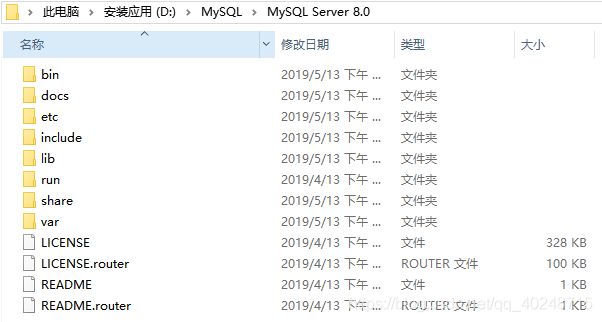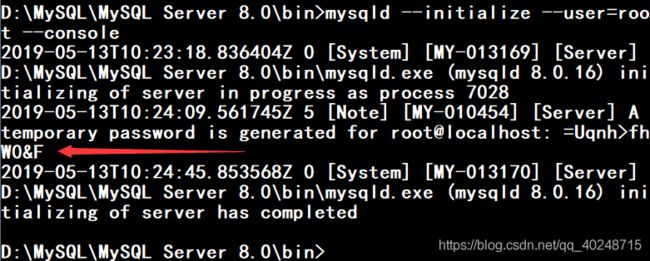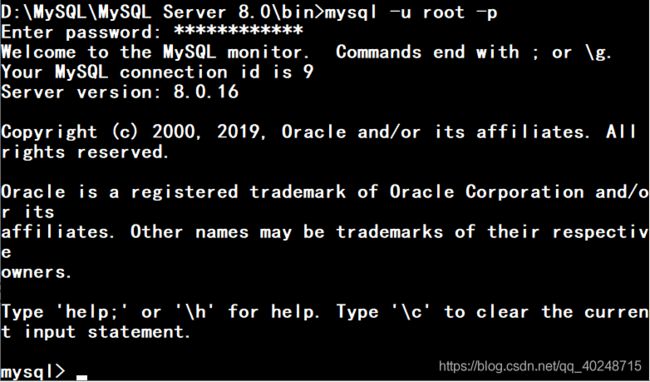Windows安装MySQL Server 8.0.16
- 一、说明
- 二、下载压缩包
- 三、将压缩包解压,并创建需要的文件
- 四、执行安装过程
- 五、修改root密码
一、说明
- 不推荐使用msi进行安装,安装过程会出错,坑很多,直接下载压缩包手动安装。
- 这篇文章也是自己折腾了很久后才安装好,想想还是写下来,也许会帮助到人,内容也大多是整合的网上的资料,但是步骤还是自己一步一步地来操作并且记录下来的。
二、下载压缩包
- mysql 8.0.16最新下载地址:http://mirrors.sohu.com/mysql/MySQL-8.0/mysql-8.0.16-winx64.zip
三、将压缩包解压,并创建需要的文件
- 既然是手动安装了,这安装位置就我们自己选择了,这里装在D盘
- 将文件解压到D:/MySQL/MySQL Server 8.0/目录下,使用msi安装就是这个目录结构,我们这里就跟他保持一致吧
- 解压好后目录结构如图:

- 在该目录下创建my.ini文件,写入以下内容,然后另存为ANSI格式(这也是msi自动安装时的坑,msi的格式不是ANSI导致服务无法启动),这个是从msi里面提取的配置文件,直接复制进去就是,可以说是很详尽的配置信息了,至于里面大小等参数就只有靠你自己测试了,还有里面参数的意思等都可以直接百度到,我这里就不过多解释了。日志那一块儿的配置那些文件名(SAMSUNG-300E5K)就改成你自己电脑的名字,当然这个无关紧要,那些日志文件到时候会生成在data文件夹里面。
# Other default tuning values
# MySQL Server Instance Configuration File
# ----------------------------------------------------------------------
# Generated by the MySQL Server Instance Configuration Wizard
#
#
# Installation Instructions
# ----------------------------------------------------------------------
#
# On Linux you can copy this file to /etc/my.cnf to set global options,
# mysql-data-dir/my.cnf to set server-specific options
# (@localstatedir@ for this installation) or to
# ~/.my.cnf to set user-specific options.
#
# On Windows you should keep this file in the installation directory
# of your server (e.g. C:\Program Files\MySQL\MySQL Server X.Y). To
# make sure the server reads the config file use the startup option
# "--defaults-file".
#
# To run the server from the command line, execute this in a
# command line shell, e.g.
# mysqld --defaults-file="C:\Program Files\MySQL\MySQL Server X.Y\my.ini"
#
# To install the server as a Windows service manually, execute this in a
# command line shell, e.g.
# mysqld --install MySQLXY --defaults-file="C:\Program Files\MySQL\MySQL Server X.Y\my.ini"
#
# And then execute this in a command line shell to start the server, e.g.
# net start MySQLXY
#
#
# Guidelines for editing this file
# ----------------------------------------------------------------------
#
# In this file, you can use all long options that the program supports.
# If you want to know the options a program supports, start the program
# with the "--help" option.
#
# More detailed information about the individual options can also be
# found in the manual.
#
# For advice on how to change settings please see
# https://dev.mysql.com/doc/refman/8.0/en/server-configuration-defaults.html
#
#
# CLIENT SECTION
# ----------------------------------------------------------------------
#
# The following options will be read by MySQL client applications.
# Note that only client applications shipped by MySQL are guaranteed
# to read this section. If you want your own MySQL client program to
# honor these values, you need to specify it as an option during the
# MySQL client library initialization.
#
[client]
# pipe=
# socket=MYSQL
port=3306
[mysql]
no-beep
default-character-set=utf8mb4
# SERVER SECTION
# ----------------------------------------------------------------------
#
# The following options will be read by the MySQL Server. Make sure that
# you have installed the server correctly (see above) so it reads this
# file.
# server_type=3
[mysqld]
# The next three options are mutually exclusive to SERVER_PORT below.
# skip-networking
# enable-named-pipe
# shared-memory
# shared-memory-base-name=MYSQL
# The Pipe the MySQL Server will use
# socket=MYSQL
# The TCP/IP Port the MySQL Server will listen on
port=3306
# Path to installation directory. All paths are usually resolved relative to this.
basedir="D:/MySQL/MySQL Server 8.0/"
# Path to the database root
datadir="D:/MySQL/MySQL Server 8.0/data/"
# The default character set that will be used when a new schema or table is
# created and no character set is defined
character-set-server=utf8mb4
# The default authentication plugin to be used when connecting to the server
default_authentication_plugin=mysql_native_password
# The default storage engine that will be used when create new tables when
default-storage-engine=INNODB
# Set the SQL mode to strict
sql-mode="STRICT_TRANS_TABLES,NO_ZERO_DATE,NO_ZERO_IN_DATE,ERROR_FOR_DIVISION_BY_ZERO,NO_ENGINE_SUBSTITUTION"
# General and Slow logging.
log-output=FILE
general-log=0
general_log_file="SAMSUNG-300E5K.log"
slow-query-log=1
slow_query_log_file="SAMSUNG-300E5K-slow.log"
long_query_time=10
# Error Logging.
log-error="SAMSUNG-300E5K.err"
# ***** Group Replication Related *****
# Specifies the base name to use for binary log files. With binary logging
# enabled, the server logs all statements that change data to the binary
# log, which is used for backup and replication.
log-bin="SAMSUNG-300E5K-bin"
# ***** Group Replication Related *****
# Sets the binary logging format, and can be any one of STATEMENT, ROW,
# or MIXED. ROW is suggested for Group Replication.
# binlog_format
# ***** Group Replication Related *****
# Causes the master to write a checksum for each event in the binary log.
# binlog_checksum supports the values NONE (disabled) and CRC32.
# The default is CRC32. When disabled (value NONE), the server verifies
# that it is writing only complete events to the binary log by writing
# and checking the event length (rather than a checksum) for each event.
# NONE must be used with Group Replication.
# binlog_checksum
# ***** Group Replication Related *****
# The base name for the relay log. The server creates relay log files in
# sequence by adding a numeric suffix to the base name. If you specify this
# option, the value specified is also used as the base name for the relay log
# index file. Relay logs increase speed by using load-balancing between disks.
# relay_log
# ***** Group Replication Related *****
# Specifies the server ID. For servers that are used in a replication topology,
# you must specify a unique server ID for each replication server, in the
# range from 1 to 2^32 ? 1. “Unique” means that each ID must be different
# from every other ID in use by any other replication master or slave.
server-id=1
# ***** Group Replication Related *****
# The host name or IP address of the slave to be reported to the master
# during slave registration. This value appears in the output of SHOW SLAVE HOSTS
# on the master server. Leave the value unset if you do not want the slave to
# register itself with the master.
# report_host=0.0
# ***** Group Replication Related *****
# The TCP/IP port number for connecting to the slave, to be reported to the master during
# slave registration. Set this only if the slave is listening on a nondefault port or if
# you have a special tunnel from the master or other clients to the slave.
report_port=3306
# ***** Group Replication Related *****
# This option specifies whether global transaction identifiers (GTIDs) are
# used to identify transactions. ON must be used with Group Replication.
# gtid_mode
# ***** Group Replication Related *****
# When enabled, the server enforces GTID consistency by allowing execution of
# only statements that can be safely logged using a GTID. You must set this
# option to ON before enabling GTID based replication.
# enforce_gtid_consistency
# ***** Group Replication Related *****
# Whether updates received by a slave server from a master server should be
# logged to the slave's own binary log. Binary logging must be enabled on
# the slave for this variable to have any effect. ON must be used with
# Group Replication.
# log_slave_updates
# ***** Group Replication Related *****
# Determines whether the slave server logs master status and connection information
# to an InnoDB table in the mysql database, or to a file in the data directory.
# The TABLE setting is required when multiple replication channels are configured.
# master_info_repository
# ***** Group Replication Related *****
# Determines whether the slave server logs its position in the relay logs to an InnoDB
# table in the mysql database, or to a file in the data directory. The TABLE setting is
# required when multiple replication channels are configured.
# relay_log_info_repository
# ***** Group Replication Related *****
# Defines the algorithm used to hash the writes extracted during a transaction. If you
# are using Group Replication, this variable must be set to XXHASH64 because the process
# of extracting the writes from a transaction is required for conflict detection on all
# group members.
# transaction_write_set_extraction
# NOTE: Modify this value after Server initialization won't take effect.
lower_case_table_names=1
# Secure File Priv.
# secure-file-priv="D:/MySQL/MySQL Server 8.0/uploads"
# The maximum amount of concurrent sessions the MySQL server will
# allow. One of these connections will be reserved for a user with
# SUPER privileges to allow the administrator to login even if the
# connection limit has been reached.
max_connections=151
# The number of open tables for all threads. Increasing this value
# increases the number of file descriptors that mysqld requires.
# Therefore you have to make sure to set the amount of open files
# allowed to at least 4096 in the variable "open-files-limit" in
# section [mysqld_safe]
table_open_cache=64
# Maximum size for internal (in-memory) temporary tables. If a table
# grows larger than this value, it is automatically converted to disk
# based table This limitation is for a single table. There can be many
# of them.
tmp_table_size=43M
# How many threads we should keep in a cache for reuse. When a client
# disconnects, the client's threads are put in the cache if there aren't
# more than thread_cache_size threads from before. This greatly reduces
# the amount of thread creations needed if you have a lot of new
# connections. (Normally this doesn't give a notable performance
# improvement if you have a good thread implementation.)
thread_cache_size=10
#*** MyISAM Specific options
# The maximum size of the temporary file MySQL is allowed to use while
# recreating the index (during REPAIR, ALTER TABLE or LOAD DATA INFILE.
# If the file-size would be bigger than this, the index will be created
# through the key cache (which is slower).
myisam_max_sort_file_size=100G
# If the temporary file used for fast index creation would be bigger
# than using the key cache by the amount specified here, then prefer the
# key cache method. This is mainly used to force long character keys in
# large tables to use the slower key cache method to create the index.
myisam_sort_buffer_size=8M
# Size of the Key Buffer, used to cache index blocks for MyISAM tables.
# Do not set it larger than 30% of your available memory, as some memory
# is also required by the OS to cache rows. Even if you're not using
# MyISAM tables, you should still set it to 8-64M as it will also be
# used for internal temporary disk tables.
key_buffer_size=16M
# Size of the buffer used for doing full table scans of MyISAM tables.
# Allocated per thread, if a full scan is needed.
read_buffer_size=256k
read_rnd_buffer_size=512K
#*** INNODB Specific options ***
# innodb_data_home_dir=
# Use this option if you have a MySQL server with InnoDB support enabled
# but you do not plan to use it. This will save memory and disk space
# and speed up some things.
# skip-innodb
# If set to 1, InnoDB will flush (fsync) the transaction logs to the
# disk at each commit, which offers full ACID behavior. If you are
# willing to compromise this safety, and you are running small
# transactions, you may set this to 0 or 2 to reduce disk I/O to the
# logs. Value 0 means that the log is only written to the log file and
# the log file flushed to disk approximately once per second. Value 2
# means the log is written to the log file at each commit, but the log
# file is only flushed to disk approximately once per second.
innodb_flush_log_at_trx_commit=1
# The size of the buffer InnoDB uses for buffering log data. As soon as
# it is full, InnoDB will have to flush it to disk. As it is flushed
# once per second anyway, it does not make sense to have it very large
# (even with long transactions).
innodb_log_buffer_size=1M
# InnoDB, unlike MyISAM, uses a buffer pool to cache both indexes and
# row data. The bigger you set this the less disk I/O is needed to
# access data in tables. On a dedicated database server you may set this
# parameter up to 80% of the machine physical memory size. Do not set it
# too large, though, because competition of the physical memory may
# cause paging in the operating system. Note that on 32bit systems you
# might be limited to 2-3.5G of user level memory per process, so do not
# set it too high.
innodb_buffer_pool_size=8M
# Size of each log file in a log group. You should set the combined size
# of log files to about 25%-100% of your buffer pool size to avoid
# unneeded buffer pool flush activity on log file overwrite. However,
# note that a larger logfile size will increase the time needed for the
# recovery process.
innodb_log_file_size=48M
# Number of threads allowed inside the InnoDB kernel. The optimal value
# depends highly on the application, hardware as well as the OS
# scheduler properties. A too high value may lead to thread thrashing.
innodb_thread_concurrency=9
# The increment size (in MB) for extending the size of an auto-extend InnoDB system tablespace file when it becomes full.
innodb_autoextend_increment=64
# The number of regions that the InnoDB buffer pool is divided into.
# For systems with buffer pools in the multi-gigabyte range, dividing the buffer pool into separate instances can improve concurrency,
# by reducing contention as different threads read and write to cached pages.
innodb_buffer_pool_instances=8
# Determines the number of threads that can enter InnoDB concurrently.
innodb_concurrency_tickets=5000
# Specifies how long in milliseconds (ms) a block inserted into the old sublist must stay there after its first access before
# it can be moved to the new sublist.
innodb_old_blocks_time=1000
# It specifies the maximum number of .ibd files that MySQL can keep open at one time. The minimum value is 10.
innodb_open_files=300
# When this variable is enabled, InnoDB updates statistics during metadata statements.
innodb_stats_on_metadata=0
# When innodb_file_per_table is enabled (the default in 5.6.6 and higher), InnoDB stores the data and indexes for each newly created table
# in a separate .ibd file, rather than in the system tablespace.
innodb_file_per_table=1
# Use the following list of values: 0 for crc32, 1 for strict_crc32, 2 for innodb, 3 for strict_innodb, 4 for none, 5 for strict_none.
innodb_checksum_algorithm=0
# The number of outstanding connection requests MySQL can have.
# This option is useful when the main MySQL thread gets many connection requests in a very short time.
# It then takes some time (although very little) for the main thread to check the connection and start a new thread.
# The back_log value indicates how many requests can be stacked during this short time before MySQL momentarily
# stops answering new requests.
# You need to increase this only if you expect a large number of connections in a short period of time.
back_log=80
# If this is set to a nonzero value, all tables are closed every flush_time seconds to free up resources and
# synchronize unflushed data to disk.
# This option is best used only on systems with minimal resources.
flush_time=0
# The minimum size of the buffer that is used for plain index scans, range index scans, and joins that do not use
# indexes and thus perform full table scans.
join_buffer_size=256K
# The maximum size of one packet or any generated or intermediate string, or any parameter sent by the
# mysql_stmt_send_long_data() C API function.
max_allowed_packet=1M
# If more than this many successive connection requests from a host are interrupted without a successful connection,
# the server blocks that host from performing further connections.
max_connect_errors=100
# Changes the number of file descriptors available to mysqld.
# You should try increasing the value of this option if mysqld gives you the error "Too many open files".
open_files_limit=4161
# If you see many sort_merge_passes per second in SHOW GLOBAL STATUS output, you can consider increasing the
# sort_buffer_size value to speed up ORDER BY or GROUP BY operations that cannot be improved with query optimization
# or improved indexing.
sort_buffer_size=512K
# The number of table definitions (from .frm files) that can be stored in the definition cache.
# If you use a large number of tables, you can create a large table definition cache to speed up opening of tables.
# The table definition cache takes less space and does not use file descriptors, unlike the normal table cache.
# The minimum and default values are both 400.
table_definition_cache=400
# Specify the maximum size of a row-based binary log event, in bytes.
# Rows are grouped into events smaller than this size if possible. The value should be a multiple of 256.
binlog_row_event_max_size=8K
# If the value of this variable is greater than 0, a replication slave synchronizes its master.info file to disk.
# (using fdatasync()) after every sync_master_info events.
sync_master_info=10000
# If the value of this variable is greater than 0, the MySQL server synchronizes its relay log to disk.
# (using fdatasync()) after every sync_relay_log writes to the relay log.
sync_relay_log=10000
# If the value of this variable is greater than 0, a replication slave synchronizes its relay-log.info file to disk.
# (using fdatasync()) after every sync_relay_log_info transactions.
sync_relay_log_info=10000
# Load mysql plugins at start."plugin_x ; plugin_y".
# plugin_load
# The TCP/IP Port the MySQL Server X Protocol will listen on.
loose_mysqlx_port=33060
四、执行安装过程
- 管理员方式运行cmd命令窗口,到mysql的bin目录

- 运行mysqld --initialize --user=root --console命令初始化数据库,执行命令后会等一段时间,会在安装目录下初始化建立data目录,并且console会显示出初始化的随机root密码,冒号后面的就是密码,记录那个密码,等会儿就用那个密码登录

- 运行mysqld --install “MySQL Service 8.0” --defaults-file="D:/MySQL/MySQL Server 8.0/my.ini"命令安装服务

- 运行net start "MySQL Service 8.0"命令或者到服务控制窗口启动mysql服务

- 启动后任务管理器查看mysqld占用内存200多兆左右,我也不知道这有点高了还是正常,我记得我原来的mysql 5.5.6占用内存2兆左右。。。。。。。。这翻倍翻得有点多。后面再看看吧…

五、修改root密码
- 先用刚刚记录的密码登录msql(mysql -u root -p)

- 运行alter user ‘root’@‘localhost’ identified by ‘123456’;命令修改root用户密码

- 修改成功后下次登录就是用你新修改的密码登录了,至此安装完成!







